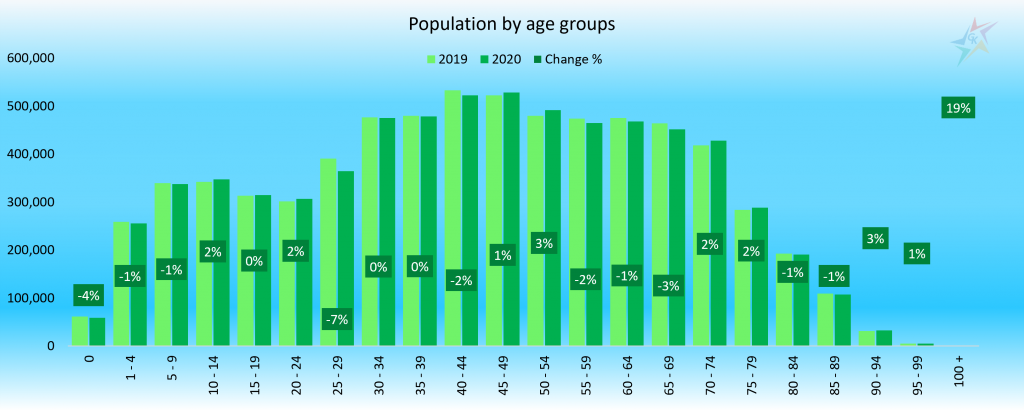In early April, the NSI published its annual statistics on demographic processes in the country in 2020. Data for previous years are always of great interest because of the trends they outline. Knowledge of the general situation in the country helps in the analysis of consumers and the environment in which the business is placed. In this topic we have collected the main key points from the current data, the impact of which we analyzed with the help of charts.
Declining and aging population of the country is one of the main trends, which is deepening in 2020. At the end of the year, the population of Bulgaria is 6,916,548 people, which means a decrease of 0.5% compared to 2019. For comparison, the population in the European Union is growing by 0.2% in 2020. Children under the age of 15 represent 14.4% of the total population. People at working age between 15 and 64 are 63.8%, and those aged 65+ are 21.8% of the nation. In 2020, the largest decline was registered by the economically active population – minus 0.7%, as well as children under 15 y.o. – minus 0.3%. The number of people in the oldest group remains unchanged, but their share compared to the other two groups rises by 0.1%. The chart presents the dynamics in different age groups in 2020 compared to 2019:

The following graph shows the average age in Bulgaria for the last 20 years:

The past 2020 is another year in which the average age of the population in the country is rising. As of 31.12.2020 it reaches 44 years of age. The problem of aging is relevant throughout the EU community – in 2018 the average age reaches 43.1 years, and by 2050 it is expected to be 50 years.
In 2020, the share of women reaches 51.6%, which is 0.1% more than in 2019. There are 1,065 women per 1,000 men. The number of men under the age of 54 predominates over the number of women. Another interesting point from the current statistics is the age structure of men and women. With the increasing of age there is an emerging tendency of increase of the number and relative share of women. The aging process is more pronounced among women than among men. One of the reasons for this is the higher mortality rate among men and, therefore, the lower life expectancy among them. Last year, the largest number of men was between the ages of 30 and 54, and for women the upper limit increased up to 74 years. Compared to 2019, the largest increase in both genders is in the age group between 45 and 54 years. The largest decline in both, men and women, was reported by the group between 25 and 29 years. The next chart shows the distribution between the different age intervals for both genders:

Another demographic feature of our country is the concentration of the population in the cities and depopulation of small settlements. As of 31.12.2020 the number of people living in cities reaches 72.9%, and those in the villages – 27.1%. Six cities in the country – Sofia, Plovdiv, Varna, Burgas, Ruse and Stara Zagora, have a population above 100,000 people and in total represents 35% of the country’s population:

It is an interesting fact that in the past year the internal migration in the country increased by 53.9% compared to 2019:

197,242 people have changed the settlement, and more than half of them (108,085 people) have preferred the life of a village to that of the city. This trend is clear from the data in the table above, according to which an average of 2% of the population leave the six largest cities. 2020 is the first year in the last ten years in which there is a greater internal migration towards villages than to the cities. The main reason for this can be found in the appearance of Covid-19 insulation and the ability to work remotely, which the pandemic imposed. The highest migration is in the direction “city – village” (48.4%). This is followed by migration in the direction “city – city” (29.9%) and “village – city” (15.3%). The migration share in the direction “village – village” has the lowest share – 6.4%.
For additional information, please contact our team via the contact form.

